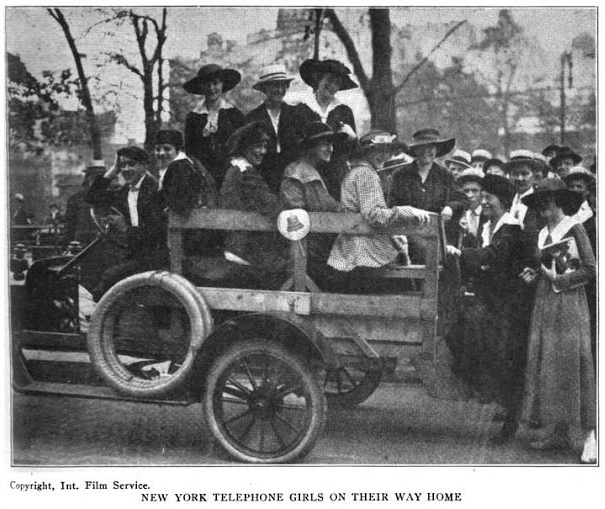You ought to be out raising hell.
This is the fighting age.
Put on your fighting clothes.
-Mother Jones
Hellraisers Journal, Monday October 9, 1916
New York, New York – The Review Reports on Street Carmen’s Strike
From this month’s edition of the International Socialist Review comes a report on the strike now being conducted by the Amalgamated Association of Street and Electric Railway Employes of America (A. F. of L.) against the Interborough Rapid Transit Company:
THE NEW YORK STREET CAR STRIKE
NEW YORK, the tremendous city of five million inhabitants, has become the Prize Ring in which is being fought one of the most colossal battles ever waged in this country between Capital and Labor. A general strike on the subway, “L” roads and street car lines of the Interborough Rapid Transit Company was declared on September 7th, in spite of the truce signed by the company and the men on August 7th. It developed that the company merely signed to gain time to organize to break the new union which has sprung up so amazingly within the past few weeks.
When it felt that it was in a position to defeat the carmen, the Interborough began to circulate the “master and servant” [individual or yellow dog] contracts the purpose of which was to destroy any benefit that might accrue thru belonging to the union. Union men on the Interborough who refused to sign were immediately discharged and at a rousing mass meeting held by the union men on the evening of the seventh, the crowd declared enthusiastically for a general strike to enforce the right of the street car men to organize into a union.
Almost from the beginning of the strike, the struggle began to take on a political, or class character. The Central Federated Union, combining all the powerful labor unions of the city voted to stand by the strikers to the last man and the last dollar. Longshoremen, firemen, engineers and boat men were among the first to rally to aid the men battling on the street car lines.
Instead of sending up the usual howl for a safe and scheduled car service, Big Business felt that the time to strike a death blow to unionism in New York city, and offered Mr. Shonts, president of the traction interests, from twenty to thirty per cent of their forces if he needed them to break the strike. Hundreds of strike breakers, at high wages, were rushed to New York, while Waddell, the Private Car King of strike-breaking bosses, raced across the continent in his own special, at a cost of $3,000 to help crush, the revolt of the car slaves.
James L. Quakenbush, attorney for the System, declared there were a lot of Columbia college students who wanted jobs as ticket sellers and choppers.
400,000 trade unionists in New York City are threatening to walk out in a sympathetic strike to aid the street carmen win their demands and President Shonts, Big Boss of the Interborough, declares that Capital intends to “go to the mat” with union labor in Manhattan right now.
As the Review goes to press it is still too early to know just how far either side will be willing to go to win this fight. The unions have not yet declared for the sympathetic strike. But if these men do go out, it will mean a great step forward for labor solidarity all over the country.
Don’t forget that the street car struggle is assuming the proportions of a political (or class) struggle. The trade unions are talking of making it a real one, and November first may yet see New York City in the throes of a momentous class war.
Later: We are just in receipt of news that 20,000 longshoremen and boatmen have gone out on strike in sympathy with the car men and that 25,000 machinists have decided to go out. Union men are predicting that if the car men are still out in a week’s time, thousands of other unionists will strike to help them win a victory.
SOURCES
The International Socialist Review, Volume 17
-ed by Algie Martin Simons, Charles H. Kerr
Charles H. Kerr & Company,
July 1916-June 1917
https://books.google.com/books?id=SVRIAAAAYAAJ
ISR Oct 1916
https://books.google.com/books/reader?id=SVRIAAAAYAAJ&printsec=frontcover&output=reader&source=gbs_atb&pg=GBS.PA195
“The New York Street Car Strike”
https://books.google.com/books/reader?id=SVRIAAAAYAAJ&printsec=frontcover&output=reader&source=gbs_atb&pg=GBS.PA213
History of the Labor Movement in the United States:
On the Eve of America’s Entrance Into World War 1, 1915-1916
-by Philip S Foner
International Pub, 1982
(Chapters 5 & 6 on phases 1 and 2 of NY Street Car Strike of 1916)
https://books.google.com/books?id=nIQFAQAAIAAJ
IMAGE
NY Street Car Strike, Telephone Girls Ride Home, ISR Oct 1916
https://books.google.com/books/reader?id=SVRIAAAAYAAJ&printsec=frontcover&output=reader&source=gbs_atb&pg=GBS.PA213
See also:
Yellow-dog Contract
https://en.wikipedia.org/wiki/Yellow-dog_contract
When Workers Organize: New York City in the Progressive Era
-by Melvyn Dubofsky
U of Massachusetts Press, 1968
(Search with: master servant yellow dog)
https://books.google.com/books?id=3RiEOA9optUC
~~~~~~~~~~~~~~~~~~~~~~~~~~~~~~~~~~~~~~~~~~~~~

